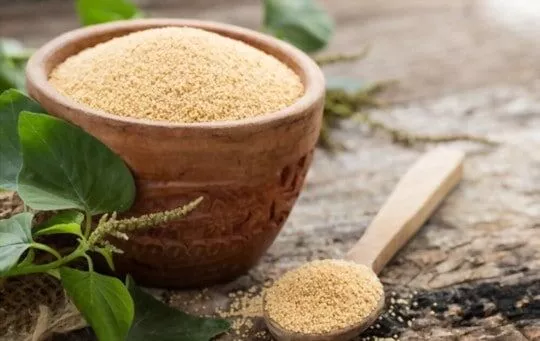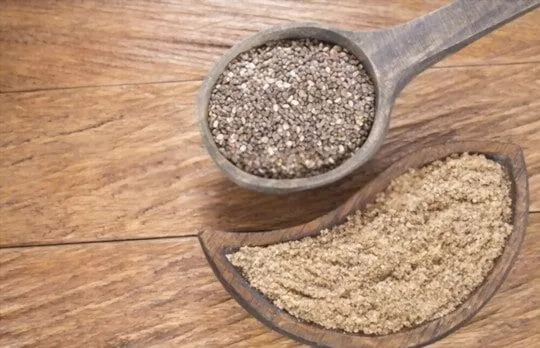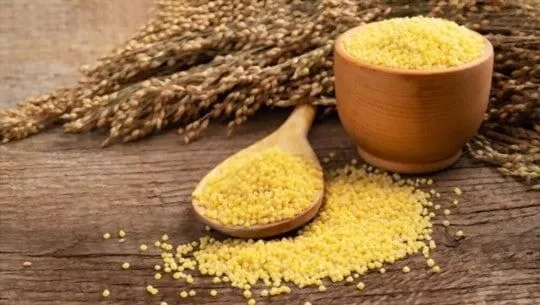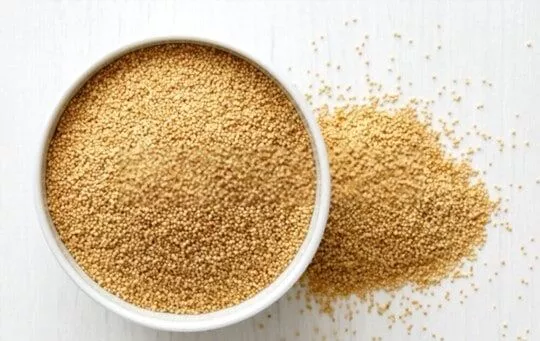Amaranth is an ancient grain that is making a comeback in modern cuisines.
This nutrient-dense seed has an earthy flavor and makes a great addition to salads, soups, and more.
But what if you can’t find amaranth or want to switch it up with something else?
What are the best substitutes for amaranth? The best substitutes for amaranth include quinoa, farro, barley, brown rice, buckwheat groats, teff, millet couscous, whole wheat couscous, oats or oatmeal. These grains will have a similar texture and flavor to amaranth once cooked and make excellent alternatives in any recipe that calls for the grain.
But which of these should you choose to replace your amaranth?
Let’s take a look at the 10 best substitutes for amaranth and how to use them.
What is Amaranth?

Amaranth is a plant species that has been cultivated for thousands of years for its edible seeds, leaves, and stems. It is a highly nutritious and versatile plant that is often used in cooking, baking, and as a grain substitute.
The amaranth plant belongs to the Amaranthaceae family and is native to Central and South America. It has been a staple food for the Aztecs and other indigenous peoples for centuries, and was even used in religious ceremonies.
The plant can grow up to 8 feet tall and produces large, vibrant flowers that range in color from red to gold. The seeds of the plant are small, round, and have a nutty flavor. They can be cooked like rice or quinoa, and are often used in porridges, soups, and stews.
The leaves of the amaranth plant are also edible and have a slightly sweet taste. They can be eaten raw in salads or cooked like spinach. The stems of the plant are also edible and can be cooked like asparagus.
Amaranth is a highly nutritious plant that is rich in protein, fiber, and essential vitamins and minerals. It is particularly high in iron, calcium, and magnesium, making it a great food for vegetarians and vegans who may be at risk for nutrient deficiencies.
The 10 Best Substitutes For Amaranth
Amaranth is a nutrient-rich food commonly used in gluten-free baking. Its high dietary fiber content makes it an ideal substitute for wheat flour, offering a healthy alternative for those with dietary restrictions.
Here are ten great substitutes for amaranth:
1 – Coconut Flour

Coconut flour is an excellent option if you’re looking to avoid grains while still enjoying the same fluffy texture and melt-in-your-mouth consistency as traditional flour.
It adds a subtle sweet flavor and delicate floral aroma to baked goods.
Coconut flour has twice the amount of dietary fiber as amaranth, making it a healthier choice overall. With its ability to hold onto moisture, it’s also useful for creating large, open crumb cakes and muffins or flaky pastry doughs.
2 – Chia Seeds Flour

Chia seeds are considered a superfood due to their high antioxidant content and essential vitamins and minerals.
Their unique characteristics make them ideal for creating nutritious gluten-free flours that can be used in place of traditional wheat flours.
Chia seed flour offers superior levels of protein and fiber compared to amaranth, providing more health benefits with every serving.
As an added bonus, this delicious ingredient also helps to promote weight loss when consumed regularly!
3 – Chickpea Flour

For those looking for a protein alternative to grain flours, chickpea flour is a great choice.
This plant-based alternative contains more than double the amount of protein found in amaranth, making it an ideal option for vegetarians and vegans looking to get their daily dose of nutrients without compromising on taste or texture.
Chickpea flour also carries higher amounts of manganese, magnesium, potassium, copper, iron, zinc, phosphorus, and folate than amaranth.
4 – Soy Flour

Soy flour is derived from ground soybeans and is recognized as one of the most nutritious plant proteins available today.
It contains all essential amino acids needed in human nutrition along with several essential fatty acids and antioxidants that deliver numerous health benefits when consumed regularly.
Soy flour is also packed with dietary fiber; one cup provides nearly half the recommended daily intake! Its nutty flavor makes it an ideal addition to all kinds of baking recipes where it can replace amaranth perfectly for a heartier texture and added nutritional value – plus, it’s naturally gluten-free!
5 – Cassava Flour

Cassava flour is derived from yuca root (also known as cassava) which has been ground into a powdery substance similar in consistency to wheat flour but containing significantly more dietary fiber – up to five times more than wheat!
It’s incredibly versatile due to its neutral flavor profile which easily absorbs other ingredients’ flavors like spices or sweeteners; perfect for adding complexity to your baking recipes without sacrificing on nutritional quality or flavor intensity.
Since cassava functions similarly as all-purpose wheat flour does when used in baking recipes but without any gluten or grain content whatsoever; you can use it interchangeably with amaranth while enjoying all its amazing health benefits at the same time!
6 – Quinoa

Quinoa is a gluten-free grain native to Latin America. It’s a complete protein, meaning it contains all nine essential amino acids.
Quinoa is high in fiber and iron, providing numerous health benefits. Its mild nutty flavor makes it an excellent substitute for amaranth in various dishes like salads and soups.
With quinoa’s versatility and nutritional value, it’s an ideal choice for anyone seeking an amaranth alternative.
7 – Millet

Millet is a small round grain that originated in Africa and Asia.
It offers an energy-rich profile while being low in calories and fat, making it an attractive option for those trying to watch their weight.
Millet’s distinctive flavor pairs well with vegetables or meat dishes, making it suitable for both savory and sweet recipes alike.
Its rich texture can serve as a replacement for amaranth in porridges or casseroles while offering the same nutritional benefits without the gluten content of wheat or rye-based products.
8 – Buckwheat

Buckwheat is often labeled as a whole grain but is actually the seed of a flowering plant related to rhubarb.
Despite not containing any gluten, buckwheat behaves similarly to traditional wheat flour when cooked at high temperatures due to its unique starch structure.
Buckwheat has been used in Eastern European cooking for centuries due to its high nutrient content and earthy taste-enhancing properties; it provides numerous health advantages such as reducing cholesterol levels and controlling diabetes symptoms.
The grain’s assertive flavor makes it an excellent substitute for amaranth when preparing savory dishes like stir-fries or hearty dumplings.
9 – Brown Rice

Brown rice is one of the most versatile grains around; its nutty aroma combines with various flavors while maintaining its richness throughout cooking processes like frying or steaming.
Brown rice has higher amounts of fiber than white rice while still containing essential minerals like selenium and manganese that are beneficial for overall health maintenance.
Given brown rice’s similarities to amaranth’s texture, incorporating brown rice into dishes that call for amaranth can provide more depth of flavor while avoiding gluten ingestion altogether.
10 – Oats

Oats have long been appreciated by cultures around the world due to their immense nutritive value; they are packed full of dietary fiber, vitamins B1 & B5, magnesium, phosphorus, and zinc among other essential minerals required by the body every day.
Oats also have several beneficial compounds that help reduce cholesterol levels; their ability to absorb liquid allows them be used across several different cuisines from breakfast cereal to savory stews or soups—a trait shared by amaranth grains which offer similar benefits without any gluten content whatsoever!
Oats are thus an excellent substitute for anyone who wants something closer than what traditional wheat products could offer yet still retains all of that nutritional value!
Conclusion
In conclusion, amaranth is a highly nutritious and versatile grain that has been used for centuries in traditional cuisines around the world.
However, if you cannot find amaranth or want to switch things up, there are plenty of great substitutes available.
From quinoa to oats, each of these grains offers its unique set of health benefits and culinary possibilities.
By incorporating these substitutes into your recipes, you can enjoy the same texture and flavor as amaranth while also reaping the benefits of a varied and nutrient-rich diet.

The 10 Best Substitutes For Amaranth
Ingredients
- Coconut Flour
- Chia Seeds Flour
- Chickpea Flour
- Soy Flour
- Cassava Flour
- Quinoa
- Millet
- Buckwheat
- Brown Rice
- Oats
Instructions
- Pick your favorite substitute from the list above.
- Follow cooking directions for your selected substitute with the proper ratio of ingredients.
Jenny has always been passionate about cooking, and she uses her platform to share her joy of food with others. Her recipes are easy to follow, and she loves giving tips and tricks to help others create their own unique culinary creations.

